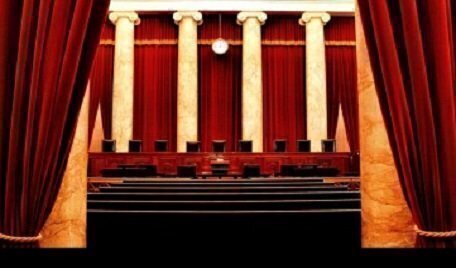The U.S. Supreme Court wraps up oral arguments this week and begins an intense period of drafting opinions in its pending cases. Will the new 6-3 conservative majority flex its muscle in key cases or seek consensus in modest rulings?

There are not many “tea leaves” to read at this point in the term, which is somewhat unusual. The justices, who began the term in October, have been behind prior terms in the pace of issuing decisions. And the newest justice, Trump appointee Amy Coney Barrett, has written only two majority opinions and they were not in major cases.
But there have been a few insights to glean from the justices’ actions so far, insights to guide us in the next few weeks and, perhaps, for coming terms.
One of the potentially biggest cases awaiting decision is a clash between religious rights and a city’s anti-discrimination policy. In Fulton v. City of Philadelphia, Catholic Social Services sued the city after the city did not renew the agency’s foster care contract because it would not place children with same-sex couples. The agency argued that compliance would violate its free exercise of religion rights.
The Roberts Court’s vigorous support of the First Amendment guarantee of the free exercise of religion has been a dominant theme in recent years. Last term, the justices ruled in favor of those asserting religion rights in several cases, one involving opposition to contraceptive health insurance, another seeking equitable school funding, and a third, strengthening church immunity from federal job discrimination laws.
But the greatest insights came from the court’s rulings on objections by churches and religious organizations to state Covid-19 restrictions. The court’s decisions generally divided along ideological lines with conservative justices—sometimes with the exception of Chief Justice John Roberts Jr.—ruling in favor of the religious objectors and the three liberal justices siding with the government in dissent.
In perhaps its most important decision in this area,Tandon v. Newsom, a 5-4 majority, led by Justice Neil Gorsuch, appeared close to overruling a 1990 decision by the late Justice Antonin Scalia, Employment Division v. Smith. The Scalia decision said that neutral, generally applicable laws do not violate the free exercise clause.
But Gorsuch wrote that “government regulations are not neutral and generally applicable, and therefore trigger strict scrutiny under the Free Exercise Clause, whenever they treat any comparable secular activity more favorably than religious exercise.” With Roberts disagreeing with decision, as did his liberal colleagues, Justice Barrett was the key fifth vote for the majority.
The Scalia decision is at stake in the Philadelphia case. Catholic Social Services has asked the court to reconsider it and that precedent now appears to be on very thin ice. Just how far is the court willing to go to accommodate religious free exercise when those rights clash with the rights of LGBT persons?
A 6-3 decision recently by the conservative majority in a case involving juvenile murders also signaled a new direction for the court. Justice Anthony Kennedy was the architect of several rulings requiring the criminal justice system to recognize that youthful immaturity is an essential element in judging and sentencing those who commit the worst crimes.
Those decisions usually split the court along ideological lines with Kennedy aligning with the court’s then four liberals to form a majority, and Roberts, Scalia, Clarence Thomas and Samuel Alito in dissent. But in Jones v. Mississippi, Kennedy and liberal Justice Ruth Bader Ginsburg were no longer on the court. Their successors were Justices Brett Kavanaugh and Amy Coney Barrett.
The court’s conservatives, led by Justice Kavanaugh, prevailed in ruling that judges are not required by those earlier decisions to make a finding that a juvenile is permanently incorrigible before sentencing the juvenile to life in prison without parole. Justice Sonia Sotomayor, writing for the dissenters, accused the majority of gutting two precedents with its decision. Kavanaugh disagreed.
While the decision is of critical importance to juvenile offenders, it also reveals how quickly the court’s jurisprudence may change with the change of just one or two justices.
Finally, the court last week agreed to hear a Second Amendment gun rights challenge to New York’s restrictions on concealed carry. The case, which will be argued next term, is the court’s first major Second Amendment challenge in a decade.
Three justices—Thomas, Alito and Gorsuch-- have expressed their unhappiness in the past with the court’s failure to hear more gun rights cases. Justice Kavanaugh also has urged the court to take a case to see if lower courts are improperly restricting the gun rights. Only four votes are required to grant review of a case, but last year, the justices denied review in about 10 gun-rights petitions even though it appeared that four justices were willing to grant review. Why?
There are many reasons why the court may decline to review a particular case, procedural and other problems. But conventional wisdom suggested that the four justices who wanted to take a case were uncertain that they could persuade a fifth justice for a majority opinion. That changed just one term later with the arrival of Justice Barrett. A lawyer who worked to win review of the New York case recently said she believed Justice Barrett made the difference this time.
Predicting what the Supreme Court will do is always risky. The cases with the potential to have the greatest impact can result in narrow rulings. And “sleeper” cases can evolve into hugely consequential decisions. This term has marked the beginning of a “new” Supreme Court. The addition of three justices in only four years has created a new dynamic on the court that could bring more surprises before the term ends in June.
Marcia Coyle is a regular contributor to Constitution Daily and the Chief Washington Correspondent for The National Law Journal, covering the Supreme Court for more than 20 years.







